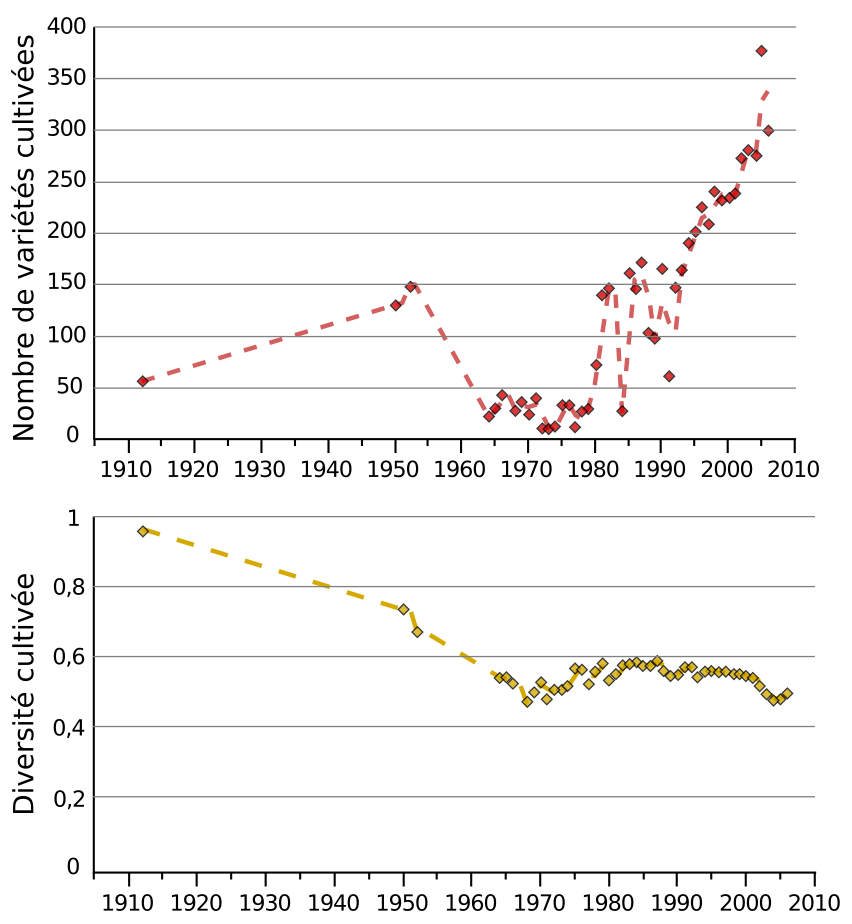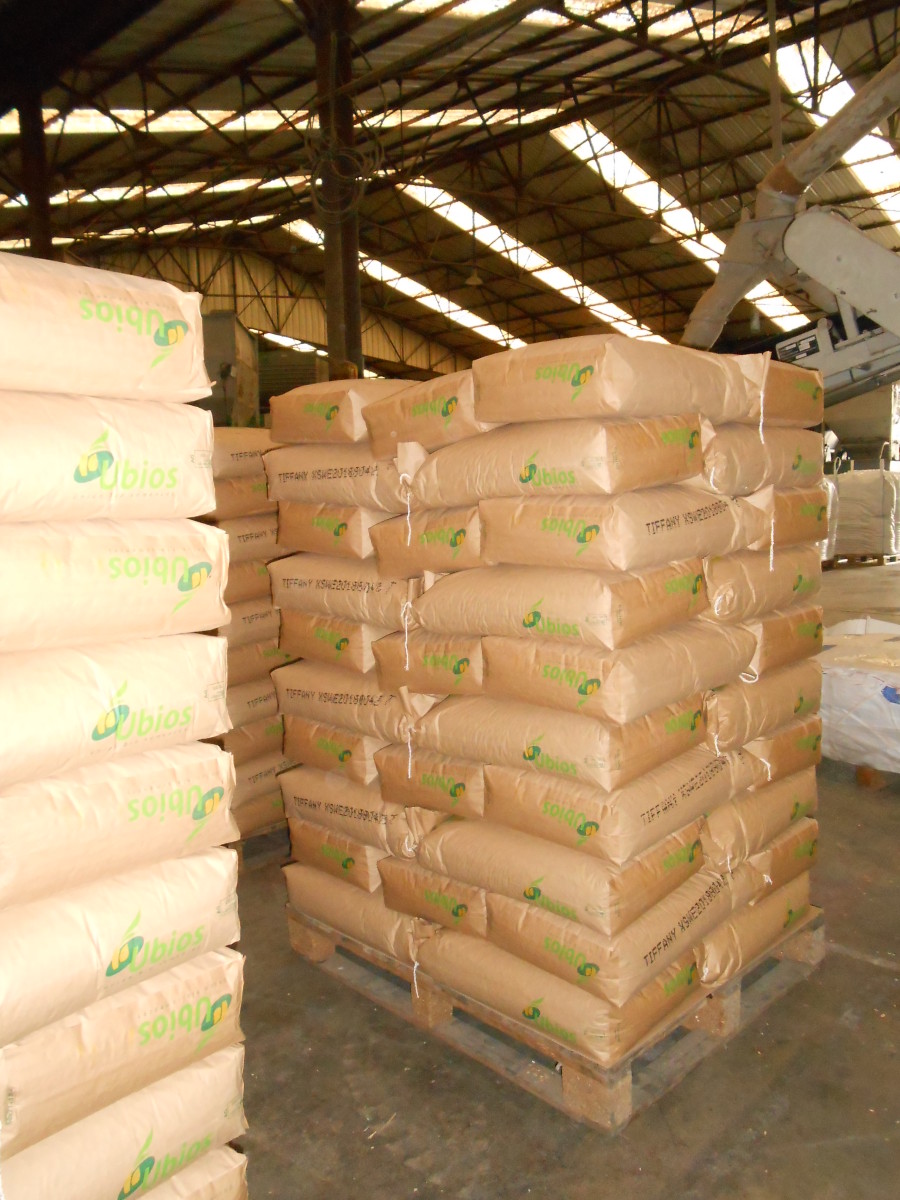Pathway to resilience n ° 4: Diversify cultivated varieties and develop autonomy in seeds
- 2020-02-01 09:34:30.0
- 14527
- seeds, seed producers
The great genetic homogeneity of modern varieties makes them vulnerable to increasingly frequent climatic or biological disturbances. The seeds are produced by specialized companies, for agro-industrial practices that are not very resilient and without taking into account specific territorial features. Faced with global threats, it is essential to develop a local network for selection and distribution of seeds, in order to have diversified varieties adapted to the territory.
State of Affairs
Homogeneous varieties from a concentrated sector
From popular varieties to modern varieties
Variety improvement has been one of the pillars of the green revolution. French agricultural production today relies on the use of genetically homogeneous varieties (pure lines, clones, and F1 hybrids). Within a given homogeneous variety, all individuals are genetically identical, with a few variations. These varieties have been selected:
- to maximize yields under cultivation conditions specific to conventional agriculture: significant use of mineral fertilizers and phytosanitary products, irrigation and heavy mechanization;
- to optimize the processing, distribution and marketing of agricultural products.
The rise of these homogeneous varieties, if it is a major factor in the increase in yields during the second half of the twentieth century, came to the detriment of the popular varieties used previously, and led to an impoverishment of cultivated biodiversity .
In 1912 in France, the varieties populations represented approximately 57% of the cultures of soft wheat, against 43% for the pure lines. In 1950, population varieties were no longer present on 8% of surfaces. While the number of common wheat varieties marketed has increased sevenfold in a century, the genetic diversity actually cultivated has halved (Figure 18) . This is explained both by the great genetic proximity of modern pure lines, and by the preponderance of a small number of them, called "elites", in cultivated areas.

Figure 18 : Evolution between 1912 and 2006 in France, for soft wheat, in the number of varieties and overall cultivated diversity. The latter aggregates information on genetic diversity between varieties and on the spatial distribution of varieties in the territory. Source : Les Greniers d’Abondance, Goffaux et al. (2011).
Field trials of various varieties of soft wheat in organic farming at INRA Rennes (Ille-et-Vilaine). Crédits : © INRA, Hélène Navier.
A geographically and economically concentrated sector
The activities of creation, selection and variety multiplication - traditionally carried out by the peasants themselves - are now supported by specialized organizations, mainly private. The current regulations strengthen this vertical structure and the industrial logic of the seed sector, because only varieties listed in the official catalog can be marketed . Registration in the catalog is binding; only varieties that meet the so-called DHS (Distinction, Homogeneity, Stability) and VATE (Agronomic, Technological and Environmental Value) tests are eligible.
The re-use by a farmer of part of his harvest as seed - known as "farm" - is allowed on payment of a "compulsory voluntary contribution" to the breeder of the variety in question. This is of little interest to hybrid varieties, whose advantageous characteristics are naturally diluted during reproduction.
The improvement of cultivated plants is therefore done essentially in a centralized manner (the participation of farmers being limited to seed multiplication contracts) and unrelated to the growing conditions specific to each territory (nature of the soil, climate, pests). The heterogeneous distribution of seed selection and multiplication activities on the territory illustrates this lack of links with local growing conditions. (Figure 19).

Figure 19 : Distribution of jobs in the seeds sector (selection and production activities) in the French departments. Source : GNIS (2017).
The French seed sector is made up of 62 groups and independent companies with a breeding / production activity, to which are added 183 production companies alone. A handful of players concentrate a very large share of the market : 16 groups and companies account for 70% of the sector’s overall turnover.
A targeted, long and complex selection process
The selection of new varieties generally seeks to meet a specific need: yield, resistance to a disease, nutritional or industrial interest… It is done most of the time in a reductionist logic , by the identification of one or more genes of interest and their introduction (or elimination) into a target variety.
The development of a new variety requires several steps: initial crossing between the selected parents, fixing the characteristics of interest by selection of the progeny over several generations, field experimentation, multiplication, and registration in the official catalog. As a result, around ten years may elapse between the first crossing and the placing on the market of a new variety. Modern techniques of biological engineering make it possible to reduce considerably the duration of fixation of characteristics and to lead to a listing in the catalog after six years.
Links to resilience ?
Associated threats : climate change, collapse of wild and cultivated biodiversity, depletion of energy and mineral resources, economic and political instability
While the functioning of the seed sector is adapted to the modern industrialized food system, it does not meet the resilience requirements that the current crises force us to take into account .
The genetic homogeneity of cultivated varieties becomes a vulnerability in an environment more conducive to climatic or biological disturbances (see Collapse of wild and cultivated biodiversity) . In general, greater genetic diversity within a plot allows better tolerance to different stresses, as well as more stable yields ,,,.
Current breeding efforts are mostly part of the input-intensive agricultural model , resulting from the green revolution. However, supply constraints (physical and / or economic) or regulatory must be anticipated for these products, in particular for mineral fertilizers and pesticides. The selection of varieties adapted to these low-input practices is still anecdotal: of the 349 varieties of soft wheat registered in the official French catalog in 2019, only five were specifically developed under organic farming conditions .
The vertical and centralized organization of the seed sector does not allow regionalized selection of cultivated varieties s. However, the consequences of climate change are not the same from one territory to another (climatic hazards, displacement of pests and diseases, etc.). In this regard, it is difficult for the current sector to provide contrasting responses adapted to local issues. In addition, an economic disruption affecting a large seed company would have serious consequences for many farms.
Modern variety selection methods do not allow rapid adaptation . Developing a new variety requires at least five years of research and advanced molecular biology technologies at best. The reductionist approach cannot target all the constraints likely to affect crops in a context of rapid and multiple disruptions.
Finally, today farmers are dispossessed of the technical knowledge and regulatory capacities to ensure their autonomy in seeds, collectively or individually .
Objectiives
A major resilience factor lies in the diversification of varieties used throughout the territory . The objective is not to cover agricultural areas with popular varieties, but to promote cultivated diversity as much as possible. This includes the use of different varieties (homogeneous or population) on a set of farms, rather than the preponderance of a few "elite" varieties. Locally selected seeds can come from modern homogeneous varieties, as well as from traditional population varieties, or from original lines.
The availability of suitable varieties requires the creation of local channels for selection, multiplication and distribution of seeds . It is about federating and strengthening existing initiatives in the area. Many farmers do not see it as their job, do not have the time or the inclination to do it, but would like to be able to use local seeds adapted to their system. The development of sectors involving both farmers and specialists in variety selection and seed multiplication makes it possible to meet this expectation, and the challenges of resilience and adaptability. In view of the importance of trees and shrubs in agroecological practices and the development of resilient territories, the seed sectors of perennial plants (nurseries) must also be strengthened.
Actionnable Levers
LEVER 1 : Promote the installation of professional seed companies in the region
Companies, farmer breeders and specialized artisans are essential links for a dynamic local seed network . They have the technical resources and knowledge to create and select new locally adapted varieties. They can then distribute them widely throughout the territory. Communities can support their installation and their activity by making land available and by supporting installation and marketing: training, networking, purchasing of certain products such as alignment trees and hedge shrubs, etc.

Seeds packaged by Union Bio Semences (Essonne), a company specializing in the production of seeds intended for field crops in organic farming. Founded by two agricultural cooperatives, it has benefited from the support of the Eau de Paris authority and the Seine-Normandy water agency. This production site supports the development of organic sectors in Île de France. Crédits : © Union Bio Semences.

The "Végétal local" brand, owned by the French Agency for Biodiversity, encourages the production of seeds and seedlings from wild plants, in particular shrubs that can help restore hedges. The existence of a training and meeting network makes it possible to set up local sectors bringing together nurserymen, farmers and local communities.
LEVER 2 : Support and accompany the development of agriculatural seed houses
Agriculatural seed houses are structures connecting peasant breeders, associations for the conservation of plant and environmental heritage, seed artisans and researchers. Their objective is the production of peasant seeds, the promotion of traditional population varieties and the conservation of cultivated biodiversity. These structures adapt to the conditions of the territory and to the desires of the people behind the various projects. They can play a major role in the animation of the local seed network and the sharing of varietal innovations.
The animation of such a network is also an important point of vigilance. The coordination of many different actors (farmers, professional seed companies, researchers, gardeners, etc.) on multiple variety experimentation and selection projects is not easy. Sufficient human resources must be allocated in order to set up appropriate organizational and exchange systems. Communities can help in this direction, by benefiting from the advice of the Réseau Semences Paysannes .

The Triticum association works to improve food resilience around Rouen (Seine-Maritime). In particular, it has the activity of Maison des Semences Paysannes dedicated to old varieties of wheat. The metropolis of Rouen provides financial support for its actions, such as the purchase of equipment for harvesting and sorting seeds. Crédits : Mae Mu, Unsplash and Triticum.
LEVER 3 : Invest in participatory research to develop new varieties adapted to local conditions and the needs of farmers
To obtain agronomically interesting local varieties, decentralized participatory selection is an innovative and promising way. It is based on collaboration between farmers and researchers for the development of selection protocols and performance indicators. Farmers have a great deal of autonomy in the selection process and benefit from networking. They can thus obtain varieties adapted to their growing conditions and preserving their evolutionary potential.
Communities can encourage the emergence of this type of program through human, financial or administrative support (project setup, grant applications).

The PaysBlé participatory selection program was carried out in Brittany between 2009 and 2012 by the Triptolème association (member of the Peasant Seeds Network) and the Sad-Paysage research unit of INRA Rennes. Wheat varieties suitable for organic farming and artisanal breadmaking have been selected from local populations and modern varieties. The Brittany region funded this research program. Photo: visit to a collection of local wheat varieties. Credits: © Triptolème.
LEVER 4: Sensitize and train farmers The use of varietal mixtures or farm seeds may require certain adaptations to technical cultivation routes. Training courses highlighting the value of these practices for the resilience of farms can remove certain obstacles and received ideas, without minimizing the constraints related to their uses. More generally, it is important to make farmers aware of the challenge of preserving and developing genetic resources, and to promote the interests of collective management.
LEVER 5 : Structure development channels to ensure outlets for local varieties
The productions from peasant seeds are less easily valued by cooperatives; they may require specific outlets. For some species, the characteristics of the products harvested do not meet the requirements of processing or mass distribution. For example, for soft wheat, the flours are not suitable for industrial baking processes. The community can support the development of processing and distribution channels allowing the promotion of these local productions , for example by adapting the calls for tenders of collective catering or by initiating the creation of brands or specific labels for these local products. Examples linked to the promotion of local products are developed in road to resilience n ° 8 .

The Slow Food Foundation for Biodiversity identifies and supports initiatives to safeguard varieties and local breeds. Its database enables local authorities to learn about and draw inspiration from the existing sectors in their territory. Crédits : © International Potato Center.
Side Benefits
Varietal selection is today one of the main levers for improving yields under low input growing conditions. Abandoned by the majority of large seed groups, it can be a major asset for the structures that take it up.
The development of a territorial seed network involves the creation of new sustainable jobs: seed artisans, artisans processors, network leaders, specialist advisers, etc.
Greater crop diversity reduces annual variations in yields, helps stabilize farmer incomes, and limits the risk of agricultural disasters. It also improves the dietary diversity of the population.
Obstacles
Constraining regulations
The main obstacle to the development and proper functioning of local seed sectors is regulatory. It is indeed illegal for a farmer to market seeds selected and produced on his farm if they are not listed in the catalog. Participatory research carried out in collaboration with scientists, technical centers and farmers thus led to the selection of population varieties of interest to farmers, but these could not be marketed or developed within their territory: these varieties did not meet the mandatory criteria for inclusion in the Official Catalog.
Indicators
- Genetic diversity within field crops
- Number of professional seed companies in the area
- Number of newly created varieties and old varieties again cultivated in the territory
- Number of channels for promoting products from local varieties


